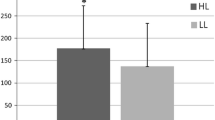Abstract
Maximal voluntary strength of simultaneous bilateral exertion is known to be small compared to the sum of the unilateral exertions. This phenomenon is called bilateral deficit and the purpose of this study was to investigate whether it operates in both upper and lower limbs. A group of 7 female and 32 male students were divided into 4 training groups and a control group. The unilateral arm or leg training group performed maximal isokinetic arm or leg extensions using each arm or leg unilaterally. The bilateral arm or leg training group trained using bilateral extensions of both arms or legs. The groups in training continued these two types of resistance exercise 3 days a week, for 6 weeks. The control subjects did not train. The improvement in power brought about by training was compared from the viewpoint of whether the limbs (arms or legs) were trained or not and whether the mode of test power exertion (bilateral or unilateral) was the same as performed during training or not. The power in the trained limbs using the same regime as that during training (3.0% after 3 weeks, 7.7% after 6 weeks) showed the largest improvement ratio. This agrees with the specificity theory in resistance training. The increase in power in untrained limbs using the same regime as during training (2.1% after 3 weeks, 3.5% after 6 weeks; P < 0.01) and the increase in power in the untrained limbs after the opposing mode of training (1.2% after 3 weeks, 2.2% after 6 weeks; P < 0.05) were larger than that of the controls (−2.5% after 3 weeks, −1.1% after 6 weeks). This suggests that the effect of resistance training was transferred to the untrained limbs (i.e. to the legs in the arm training group and to the arms in the leg training group). The degree of bilateral deficit (bilateral index, BI) in the trained limbs of the bilateral training group was shifted in a positive direction (4.2% after 3 weeks, 3.7% after 6 weeks) and that in the trained limbs of unilateral training group was shifted in a negative direction (−3.0% after 3 weeks, −5.4% after 6 weeks) by 6 weeks of training. The BI in the untrained limbs of the unilateral training group was shifted in a negative direction (−1.9% after 3 weeks, −4.5% after 6 weeks) by 6 weeks of training, whereas that in the untrained limbs of the bilateral training group was not shifted in a positive direction (−0.1% after 3 weeks, −2.4% after 6 weeks). These results would suggest that bilateral deficits in the upper and lower limbs are at least partially affected by some common mechanism at a supraspinal level.
Similar content being viewed by others
Author information
Authors and Affiliations
Additional information
Accepted: 3 March 1998
Rights and permissions
About this article
Cite this article
Taniguchi, Y. Relationship between the modifications of bilateral deficit in upper and lower limbs by resistance training in humans. Eur J Appl Physiol 78, 226–230 (1998). https://doi.org/10.1007/s004210050411
Issue Date:
DOI: https://doi.org/10.1007/s004210050411




